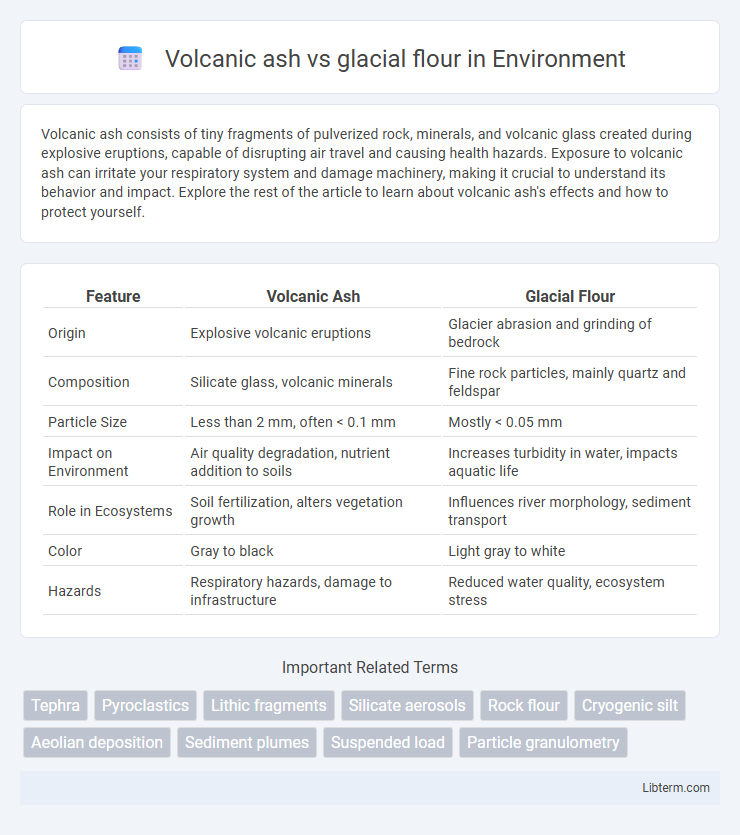Volcanic ash consists of tiny fragments of pulverized rock, minerals, and volcanic glass created during explosive eruptions, capable of disrupting air travel and causing health hazards. Exposure to volcanic ash can irritate your respiratory system and damage machinery, making it crucial to understand its behavior and impact. Explore the rest of the article to learn about volcanic ash's effects and how to protect yourself.
Table of Comparison
| Feature | Volcanic Ash | Glacial Flour |
|---|---|---|
| Origin | Explosive volcanic eruptions | Glacier abrasion and grinding of bedrock |
| Composition | Silicate glass, volcanic minerals | Fine rock particles, mainly quartz and feldspar |
| Particle Size | Less than 2 mm, often < 0.1 mm | Mostly < 0.05 mm |
| Impact on Environment | Air quality degradation, nutrient addition to soils | Increases turbidity in water, impacts aquatic life |
| Role in Ecosystems | Soil fertilization, alters vegetation growth | Influences river morphology, sediment transport |
| Color | Gray to black | Light gray to white |
| Hazards | Respiratory hazards, damage to infrastructure | Reduced water quality, ecosystem stress |
Introduction to Volcanic Ash and Glacial Flour
Volcanic ash consists of fine particles of fragmented volcanic rock and glass created during explosive eruptions, impacting air quality and soil fertility. Glacial flour, produced by the grinding of bedrock by moving glaciers, comprises extremely fine silt that imparts a milky appearance to glacial meltwater. Both materials play significant roles in shaping landscapes and influencing ecological systems through sedimentation processes and nutrient cycling.
Origins and Formation Processes
Volcanic ash forms from explosive volcanic eruptions that pulverize rock into fine particles composed mainly of glass, minerals, and rock fragments. Glacial flour is created by the mechanical grinding of bedrock beneath moving glaciers, producing ultra-fine silt-sized particles rich in mineral content. Both substances differ significantly in origin, with volcanic ash resulting from volcanic activity and glacial flour originating from glacial erosion.
Physical and Chemical Composition
Volcanic ash consists primarily of fine particles of fragmented volcanic glass, minerals, and rock, characterized by a high silica content and reactive surface area, often containing elements like sulfur and iron oxides. Glacial flour is composed of finely ground rock particles produced by glacier abrasion, dominated by quartz, feldspar, and clay minerals with low chemical reactivity and limited soluble ion content. The key physical distinction lies in volcanic ash's angular, abrasive texture and glass fragments versus the more rounded, silt-sized particles of chemically inert glacial flour.
Particle Size and Texture Comparison
Volcanic ash consists of fine, angular particles typically less than 2 millimeters, characterized by sharp edges and a rough texture due to rapid cooling of molten rock. Glacial flour, however, comprises extremely fine, silt-sized particles often smaller than 0.063 millimeters, produced by mechanical grinding of bedrock under glaciers, resulting in a smooth, powdery texture. The significant size difference and contrasting surface textures influence their transport, sedimentation, and environmental impact in distinct ways.
Impact on Air and Water Quality
Volcanic ash significantly reduces air quality by releasing fine particulates and sulfur dioxide, leading to respiratory issues and acid rain. Glacial flour, composed of finely ground rock particles, primarily affects water quality by increasing turbidity and sediment loads in rivers and lakes, which can disrupt aquatic ecosystems. Both substances influence their environments, with volcanic ash posing more immediate airborne health risks and glacial flour exerting prolonged impacts on freshwater clarity and sedimentation.
Effects on Soil and Agriculture
Volcanic ash enriches soil with essential minerals like potassium, phosphorus, and trace elements, enhancing fertility but can initially cause soil acidity and physical crusting that hampers seedling growth. Glacial flour consists of fine, mineral-rich rock particles that improve soil texture, water retention, and nutrient availability, promoting robust plant development in agricultural fields. While volcanic ash may temporarily disrupt crop production after an eruption, glacial flour generally supports long-term soil health and sustainable agriculture.
Influence on Climate and Weather Patterns
Volcanic ash influences climate by injecting fine particles and sulfur dioxide into the atmosphere, which can reflect sunlight and cause short-term global cooling. Glacial flour consists of finely ground rock from glaciers that can affect albedo when deposited on snow and ice, potentially accelerating melting and impacting regional weather patterns. The atmospheric residence time of volcanic ash is shorter than sulfate aerosols, but both play significant roles in altering Earth's radiative balance and hydrological cycles.
Hazards and Environmental Risks
Volcanic ash poses significant hazards including respiratory issues, contamination of water sources, and damage to machinery and infrastructure due to its abrasive and fine particulate nature. Glacial flour, consisting of finely ground rock from glacial erosion, can increase turbidity in water bodies, disrupting aquatic ecosystems and affecting fish populations by altering light penetration and oxygen levels. Both materials contribute to environmental risks by impacting air and water quality but differ in their sources and specific effects on human health and ecosystems.
Industrial and Practical Uses
Volcanic ash is widely used in the cement and construction industries due to its pozzolanic properties that enhance concrete strength and durability. Glacial flour, consisting of finely ground rock particles, is commonly utilized in agriculture as a natural soil conditioner to improve nutrient retention and soil aeration. Both materials find applications in environmental remediation, with volcanic ash aiding in water filtration and glacial flour used to promote soil regeneration.
Summary: Key Differences and Similarities
Volcanic ash consists of fine particles of pulverized rock and volcanic glass created during explosive volcanic eruptions, while glacial flour is composed of finely ground rock produced by glacial erosion and grinding. Both materials share similar particle sizes, typically less than 0.063 millimeters, making them highly suspensible in water and air; however, volcanic ash often contains sharp, angular fragments and volcanic glass, whereas glacial flour particles are more rounded and mineral-based. These differences influence their environmental impacts, with volcanic ash affecting atmospheric conditions and soil fertility, and glacial flour contributing to lake turbidity and nutrient cycling in glacial-fed ecosystems.
Volcanic ash Infographic

 libterm.com
libterm.com